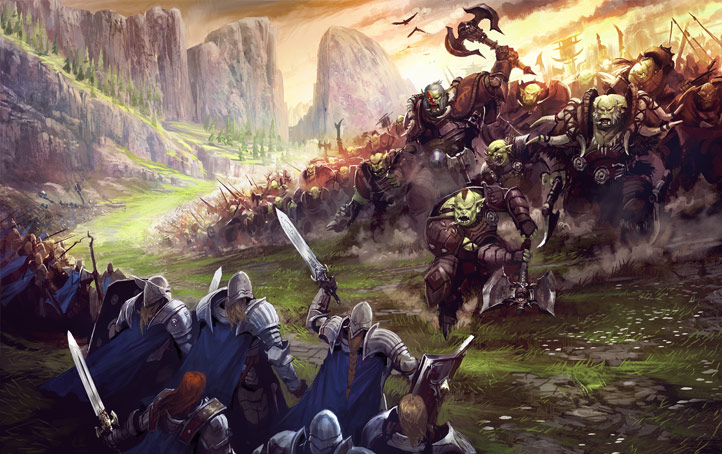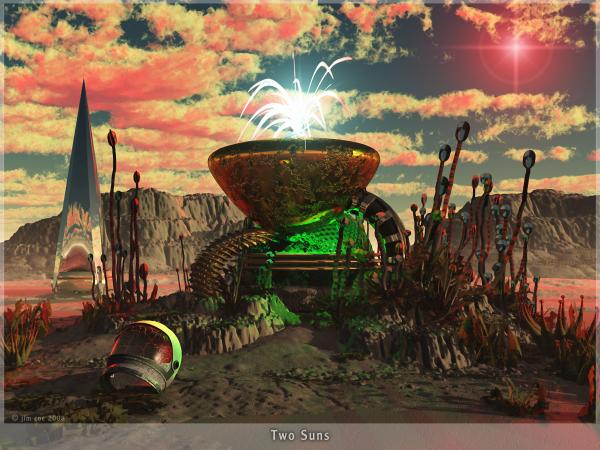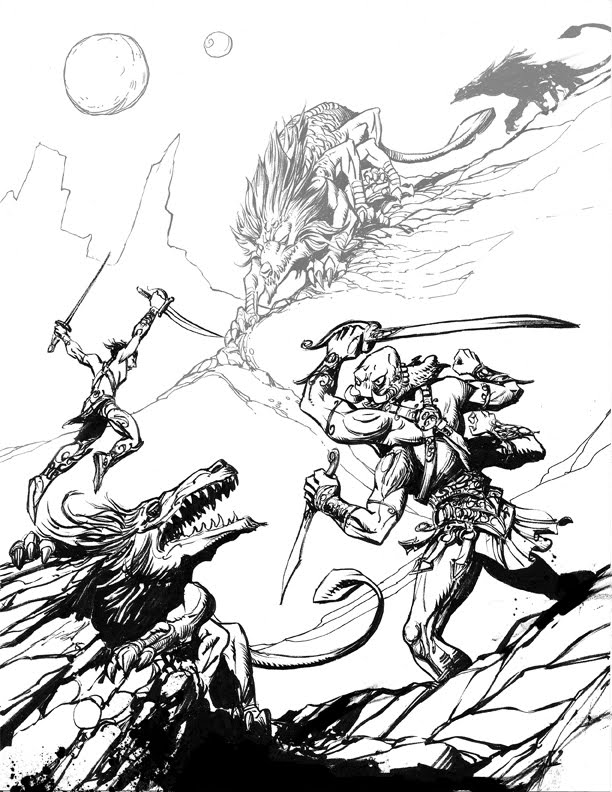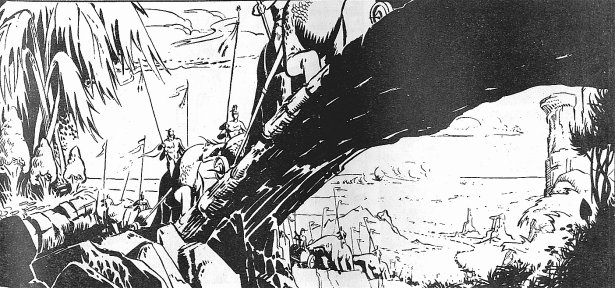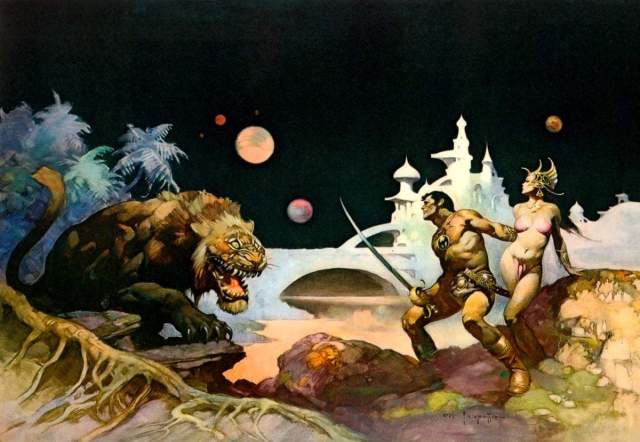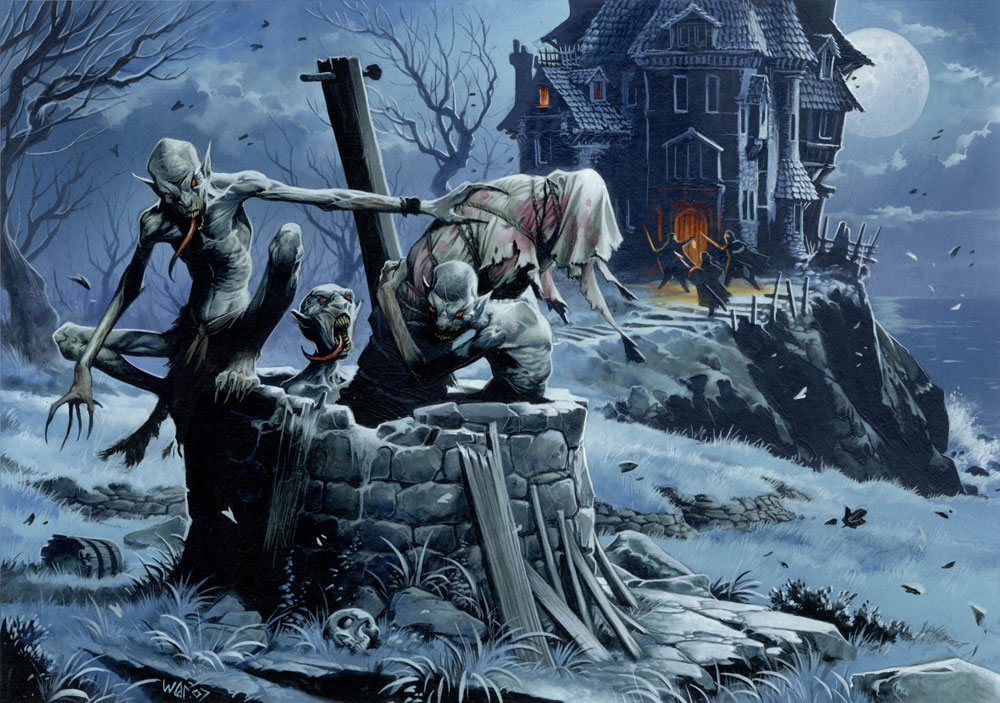
In the realm of D&D-esque games that sometimes have a D20 stamped on them or an OSR reference therein, it appears that I have finally and irrevocably surrendered to Pathfinder. I've got my weekly Wednesday night game going (which has gone gonzo and the group now runs two alternating adventuring parties....lets just say there was too much plot for just one group and leave it at that!) and of course my now closing in on three years long Pathfinder Saturday group. There comes a time when I realize, "well dang, this is the only fantasy RPG with D&D-like themes I'm running right now," that maybe I should hand it the prize.
Now, this has no bearing on Traveller (the other game I am running Saturdays), nor does it affect plans for the near future with Mutant Epoch or BRP/Magic World. Those are decidedly not D&D-likes or D20 variants. But it does mean that I think I can pat myself on the back. I stuck to my new year's resolution and by golly we're four months in and I have not fallen off the wagon.
To celebrate, I am going to print a brief summary of the campaign chronology for the ongoing Saturday group. It's not heavy on specifics, and it is mostly use as a quick recap or an intro for new players on "what has come before." So, here you go:
Current Crew of the Ship With No Name:
The crew changes a lot, but the following characters have remained consistent throughout the tale:
Captain Salmut, ratfolk swashbuckler
Horus, human monk
Reyvan, elvish monk
Pennywhistle, Halfling bard
Jerro, human sorcerer
A medley of NPC sailors and henchmen as well as rotating and new players flesh out the mix.
The Warlords of Lingusia: Tales of the Ship With No Name
The campaign opened with the tale of our intrepid adventurers on their unnamed brigantine warship. They had returned to Port Sadrys, their home, after some absence out adventuring. On arrival, they thwarted a pirate assault by Golmadran privateers and drove them out of the harbor.
The group spent a bit of time in port before being hired to escort a group of religious pilgrims ot the Temple of the Red God, thirty miles east in the mountains near the city of Senempar, home of the ratfolk captain Salmut. After some adventures in the mountains they arrive.
Senempar is a sprawling, cosmopolitan city in the mountains dominated by several humanoid races, and was founded centuries ago near the Monastery of Ashuar during the Plague Years, when the undead plague of the Shadow Gods ran amok across the world.
The adventurers spent some time in Senempar before taking leave. During their time here they pursued a shape shifting beast that favored the form of a giant slug and was murdering drunks in the night, they assisted the temple of the Red God on some errands and then turned on the temple when they realized that the ancient artifact they were to deliver to the Tomb of the Red God in the eastern Tomblands was actually a device that might awaken a deity which was aligned with chaos and sought the destruction of mankind through dreams, and they got involved in the local criminal guilds, attempting to set up an extortion racket by which they would play one guild off another and make money off of it.
Eventually the group left Senempar and journeyed south, taking with them the mysterious Key of the Red God, the artifact that would awaken the ancient deity of nightmares, to find a way to dispose of it. They were also escorting an ashtarth dark elf woman who intended to marry a high ranking noble in Golmadras to the south, but who needed protection from a former suitor who had been turned into a drider scorpion man.
The adventurers headed south along the Nyarlith Straights to the Inner Sea, and along the way cultist fishmen (skum) of the chaos lord called the Kraken attacked the ship. They were then accosted by shadow demons while in a southern Octzellan harbor, and subsequently journeyed eastward to a Golmadran Port. At the port they were confronted by the drider who pursued them for his former bride, but one of the crew, a mixed-breed dark elf woman, convinced the drider to forget her and left with him. The patron drow was able to continue on to her arranged marriage and settled her debts with the adventurers then.
No sooner had they settled into port and resolved the matter than did the Kraken itself manifest to take vengeance upon them. As the Kraken descended to destroy the city, the seraph Aion, agent of the god of time (Huuarl) manifested and spirited the entire crew of adventurers and their unnamed ship back in time nearly 1,600 years, with an urgent mission: they had to stop an ancient prophecy from coming true, one which would ultimately see to the unbinding of twelve ancient chaos gods called the Skaeddrath, of which the Kraken was but one. When the twelve are freed by this prophecy, Aion explained, they would begin to awaken from their perpetual slumber and escape into the world to wreak untold havoc.
The adventurers were told by Aion to seek out the man who started it all: a priest and scholar studying an ancient ruin in the High Plateau near the Octzellan city of Dagger Falls to the west. As a final act of assistance Aion teleported the entire ship to a small lake near the edge of the ruins, where the adventurers could seek out this scholar and stop him. Aion gave them the Hourglass of Huuarl, a sacred relic, to aid them. The rat captain abused it a lot.
The time in the ruins was fraught with danger and mystery, and at first the scholar and his assistants appeared to be innocently discovering the relics of an ancient cult in the ruins, while the scholar wrote down the mysterious language he was translating, but in time it was revealed he was receiving messages to translate in his dreams, from an ancient entity that was trapped beneath the plateau, one of the chaos gods. At last when his treachery was revealed as a true cultist of the Kraken seeking to do the bidding of this god through its dreams, the adventurers confronted him and defeated the chaos beast he summoned to stop them.
After destroying the scholar’s book and insuring that the prophecy would never be written and so could not come to pass, the adventurers traveled to a nearby ancient cave where a hidden temple of time to the god Huuarl could be found. The angelic Aion manifested after the hourglass relic summoned him and informed them that the timeline had been changed, and the Kraken and its ilk were no longer certain to destroy the world in the current era. When asked, the adventurers chose to return to the future, their present, and Aion did so, repairing their damaged vessel (it was shattered when it hit the shallow lake) and setting them in the grand lake off Dagger Falls nearby.
The heroes returned to the present, where they began to find subtle changes. Octzel as a kingdom was no longer a wasteland of small baronies fighting against the monsters and the foreign invaders of Zatacan, but was united into three kingdoms, of which they were now in the domain of southern Pheralin.
The group became embroiled in a mystery in the city of Drakhan, where murders with a demonic influence were happening. They discovered that someone had unleashed a powerful ancient demon, the cambion half-demon bastard son of the ancient northern giants (Balor himself).
The group traveled to a monastery and while defending the monks from rampaging cyclopses learned that the taint of the demons may stem back to an ancient elvish city which once existed in the middle of the northern Halale Wilderness, near a sacred tree. They traveled to these ruins and discovered that the sacred tree had been corrupted long ago in whatever conflict destroyed the surrounding city. A series of adventures led to the revelation of the demon himself, and his subsequent banishment, as well as the restoration of the Sacred Heart of the Tree, which purged the region of this evil influence.
The group returned to Drakhan and spent a bit more time there before journeying to Pheralan, capitol of the kingdom, just south along the river delta from Drakhan. There they met with Queen of the land and learned that her son had been missing for over a year, and a dignitary from the distant eastern city of Carapus in the Sea of Amech region had just arrived, bearing the sword of her son which he said had been recovered from the wreckage of his ship, and though no body was present, he felt news of this matter had to be delivered to the Queen.
The queen asked the adventurers to accompany the ambassador as well as her own agent, named Biramon Black, agent of the queen, to go to Carapus and recover her son, alive or dead. She provided them with rare resurrection scrolls to insure he came back alive if possible. The group accepted.
A lengthy journey north from the Inner Sea to the Nyarlith Straight, then eastward through the Baldric Gulf along the shores of the Northern Hyrkanian Kingdoms was fraught with various minor dangers, but the group stopped for a time in the city of Eor’nin to repair and resupply before journeying into the Sea of Amech region.
While in Eor’nin, they picked up a priest and paladin and became involved in the investigation of a haunting at the local museum of antiquities sponsored by Eor’nin’s king. The haunting was actually from a Hettanar Warlord’s sarcophagus that had somehow become a portal to a mysterious demiplane which abutted with the Far Realm. The adventurers were trapped (sort of) here for sometime before they sealed the portal to the Far Realm and escaped, haunting purged.
The group eventually found their way in the Sea of Amech region, dealt with trollish piracy and captured a trollish war galleon filled with an ancient, evil idol of the mysterious troll god Tsthaqqua. They were close to Carapus at last when they witnessed an island rise from the sea, beckoning with naked elf maidens on its shore. So naturally they dropped anchor and rowed to the mysterious isle.
Here they discovered an ancient island of somehow artificial construction that could submerge at the will of an ancient abolethic demiurge named Seredath. The aboleth had an obsession for kythien elvish women, whom more than a hundred were kept on the island for reasons unknown. While there the adventurers discovered that local ape men and kobolds worshipped two local beast lords, a massive girallon and a giant tyrannosaurus rex. They also encountered the terrible volcanic “fire god,” a volcanic dragon, which the monks smacked down in about eighteen seconds while Captain Salmut lopped its head off.
The group found the crater at the center of the island and an ancient abolethic city within. They had taken refuge inside one of the buildings with the elvish women they sought to rescue when the island submerged once more. Now traveling like a mile wide submersible beneath the Sea of Amech, the group made their way through the maze of the city until they reached what the elvish woman called “The Great Machine.” Aquatic Giants , skum and other evil agents of the aboleth operated this machine that appeared to be powered by the spirits of the elvish women, who were drained like batteries in the machine.
The group tried to get to the center of the machine for sabotage but discovered that it was also apparently a tether to multiple planar rifts, one of which opened up into a fragment of a shattered plane which was once the Great Cog of the Modron of old. They acquired two relic modrons while fighting the corrupted machine-monsters of this planar fragment before making it safely back.
The group reached a point where they had alerted the denizens of the island to their presence, and Seredath’s watchdog, a terrible shoggoth, began pursuit. The group took refuge in a bathysphere which they learned to operate and make a quick escape. Now free of the island, the group found themselves deep beneath the Sea of Amech, near one of many ancient ruins from the pre-deluge era of old.
Finding a cavern within the submerged ruins along a great and ancient mountain, they discovered an ancient hollow that contained what seemed at first to be an ancient monument and tomb to a forgotten king or god. They determined it was a monument, commemorating an ancient victory when the avatar Avokta of the lost war god Vishannu destroyed the ancient lizard man empire of Codam, and imprisoned their dark god Orcus within a demonic soul gem. The group, while battling various evil entities, uncovered the soul gem.
Some time ago the rat captain Salmut had found two weapons. One was a shadow blade that wa tethered to the demiplane of shadow and reflected the ancient spirit of the lost god of that realm named Avarath, slain by the Shadow Pantheon of Unarak who usurped his realm. The other was forged from the bones of chaos gods and was a tether to the Far Realm. It was during this inopportune moment that the ratfolk captain used the blades to forge a portal to the Far Realm where it could not quickly be closed, and the means of getting to that portal was sealed off. This insured that the army of the star-faring Neh-Thagglu brain collectors now had a permanent passage to the earthly realm of Lingusia.
The group also encountered the missing prince while exploring the aquatic hollow, as the prince and his surviving compatriots (including a psionic warrior of great skill) had been delving into the subterranean realm looking for a lost artifact to the god of knowledge, Nistur, whom the prince believed could be revived if one took up the mantle of the artifact and became an avatar of this fallen god from the old empire. Instead, it was revealed to be a trick, and the voice which compelled the prince was that of Orcus and his demonic minions seeking escape. The group fought the demons which manifested with the prince’s possession and also freed the prince momentarily from Orcus’s control.
The group eventually left by way of a teleport established with their tiefling sorcerer on board their still unnamed ship. They resumed their journey to the city of Carapus.
At last reaching Carapus, the group held court with the queen, the ambassador, the prince and the dignitaries of the realm which included the naga of the sunken citadel of the coast, which had now had a tentative alliance with the surface dwellers for a while now. It quickly became problematic as it turned out the prince had engaged in an affair with the queen of Carapus, her daughter, and the naga queen. The warlord naga king took great umbrage at this reveal and challenged them all to a duel, but wa defeated.
The group spent several weeks in Carapus, with the monk Horace staying to found an orphanage in a city that very much needed it. The psionic warrior Galvado began investigating the connections revealed through a series of adventures of mind flayers that belonged to a mysterious Guild of the Spheres and seemed to have gained some trust from them. The other adventurers got embroiled in stopping a slavery ring and the group also earned the ire of a guild of war mages who did not like the influence the group was having on the city political scene.
The naga warlord eventually struck and took the prince hostage in revenge for the prince’s indiscretions, and held him for an outrageous ransom. The group attained underwater spells and journeyed to the sunken city of the naga, where they found a back way in, gained some Locathah allies, and assaulted the inner citadel.

While in the ruinous dungeons beneath the citadel the group accidentally awoke a vampiric priest lord of Set named Ollaram. As it turns out there was a guardian spirit servant of the goddess Phonatas present, an entity which resided there in a ruined shrine to the goddess to suppress the vampiric avatar from awakening. This spirit channeled the essence of the goddess, who made a pact of assistance with the bard Pennywhistle, granting him a divine bowl by which he could commune with her, and ask a favor of her in times of dire need.
Meanwhile, the less scrupulous side of the party found a portal to the Nine Hells in the bowels of the ruins, and somebody thought this was a good time to get rid of the Demonic Soul Gem in which Orcus’s spirit was trapped, so they threw it in. This led to a large explosion and much confusion. The group retreated to the locathah village, where they mended themselves for a day or so.
When they returned to the citadel of the naga, it was clear an undead plague had been unleashed by an Orcus who had been freed from his soul gem. The group eventually found and rescued the prince from a slavering horde of fresh vampires after securing the aid of an ancient reef dragon, and they then made good their escape.
Captain Salmut was asked on his return to Carapus to next investigate a ship which had been wrecked in battle that contained the remains of a powerful ancestor of a local noble. The group also got wind of rumors that the island kingdom of Kadantania was preparing to set sail to attack Carapus in a bid to expand its power base. They opted to pursue the wrecked ship.
The group sailed to the region in question, and along the way were accosted by giant froghemoths that emerged from the Vyrindian Isles. They discovered these beasts had been made by a witch woman who used these transformed sailors from the wreck to guard an ancient temple. The group saved two fo three transformed sailors, the made their way to the coast where they found the wrecked ship.
The ship was surrounded by undead, but they survived. The adventurers found the crate with the remains, but the canopic jars within had been stolen. The sorcerer Jerro took the ornamental rune in silver that protected the crate for a talisman, however.
The tracks led past an ancient half-dome with a tower in the jungle, inside of which an ancient clockwork golem acted as caretaker for a forgotten temple of the old gods. The trolls protected the temple from entry but the adventurers fought their way in. For their reward they were recognized as divine emissaries and allowed to access the lower temple. There, the monk Reyvan communicated with the high god of the old empire’s pantheon, Naril, and learned that the ancient artifact he had come into possession of, a gauntlet-like weapon called the Star of Naril, was the weapon of the chosen avatar of the god, and it would let him find the lost island of Sol’Dranir where Naril’s temple of light could be found. The island had been clouded by agents of the Shadow Pantheon long ago, for the temple of the god of the sun and man was the greatest threat to Unarak and his cronies. Naril’s spirit charged Reyhvan with going to the temple and freeing it from the shadow’s grasp.
They also learned that eastward in the mountains was a great excavation underway by the troll queen, who had stolen the relics of the dead saint-avatar they had been sent to recover. Her vanity led the troll queen to seek out a means to abolish her race’s impurity and seek perfect beauty by use of the saint’s otherworldly power. The adventurers are also charged with recovering these artifacts.
The adventurers entered the second temple of the demiurge of knowledge, Warenos, and successfully petitioned the living demiurge for an audience in the Weirding Realm (the feywild). There they gained access to his copious body of knowledge, and also discovered an agent of Orcus that had been trailing them, a creature that could not hide in the fey realm. After destroying the demon, Warenos provided them with copious advice and urged them to seek out more answers in the domain of the troll queen.
The group left the temple after some more antics, and did indeed proceed to scout out the vast excavation site unearthing the ancient temple of the trolls. They learned several important bits of information, including the fact that lizard men had an encampment there with diplomats seeking to open relations with the troll queen, a weird race of invisible winged monkeys plagued the ratkin captain Salmut, and that most of the labor force were demihuman slaves including humans, orcs, dwarves, some elves and Halflings. The worst news was that the troll queen Sytaria was sacrificing children and Halflings to the dark god Tsathoquaa at the top of the temple each night to perform rituals to improve her beauty (though precisely how much a troll woman could benefit from this was ill defined). She was using the canopic jars of the solar avatar in this deed as well, a heinous act.

The group took action that night, assaulting the height of the temple in a furious battle to free children and Halflings while defeating the troll guards and priests, as well as a massive troll abomination that was the temple guardian. The fight was brutal, but they recovered the jars and captured the queen in the process. Pennywhistle the bard then called upon his gift from the goddess Phonatas, beseeching her to intervene.
The goddess did indeed intervene. It was revealed that the trolls were actually a corrupted fey race of proto-elves from twenty thousand or more years ago, the first of whom had been lured to an ancient pool where the whispering voice of Tsathoquaa came in dreams and tempted them with immortality and power in exchange for undying devotion. When the first Endreti fey accepted this offer, she became a troll, and she was charged with luring or capturing her kin and bringing them to the pool for conversion. Thus did Tsathoquaa create the first endreti trolls. The current troll queen harbored a racial memory of that lost age, being a direct descendent of the first troll queen.
Phonatas channeled holy energy through the spirit of her bardic champion, and purged the temple and the trolls completely of Tsathoquaa’s influence. Within moments the trolls were stricken and carbonized as if burned to cinders, but from their husks emerged the true elf-like endreti fey that existed deep within, lost for eons. The troll kingdom was wiped out in moments. The temple itself was swallowed up by the earth, to insure the Skaeddrath did not awaken.
The adventurers stayed for some time to assist the newborn endreti fey in re-establishing their culture and keeping some control, as their evil and corrupt forms had been utterly purged. The slaves were freed, and efforts to return them to their proper lands enacted. The temple to the west was properly secured and offered to the newfound endreti fey as a place to restore worship of the gods of order. But at last they had to leave, faced with the task of returning the canopic jars of the avatar-saint of Naril.
By now the group had determined that they had a magical sextant and the Star of Naril, two devices that would let them find the shadow-shrouded isle of Sol’Dranir, where the ancient Temple of the Star Mount could be found, the proper resting place of the sun god’s avatars, and the conduit of his ancient power. The Shadow Pantheon had long suppressed the dominion of Naril, and they decided to head to this isle in the northern straights off the lands of Covarte and put this matter to right once and for all.
Along the way they found evidence that the Kadantanian Empire, emboldened by the return of Orcus as their chief deity, were now cutting a swathe of conquering destruction through the Amechian kingdoms. Covarte’s entire naval fleet was decimated, and a surviving ship was found horribly corrupted by demonic necromancy. The group pressed on, avoiding distraction, until they at last arrived at the shadow-shrouded realm of Sol’Dranir, made visible by the use of the magical artifacts.
The group fought off a wave of shadow demons as they transited into the demiplane where the isle had been displaced, and at last made a beachhead on the eastern shores, just south of another ancient temple, this one to Unarak himself. They encountered an expatriate shadow demon who identified himself as a true follower of the old shadow gods Avarath and Penumbros, and he offered to serve as a guide. The group forged their way through the dense, swampy wooded inland toward the great mountain chain at the center of the isle. Along the way they encountered other-dimensional undead demons (devourers) that floated in the woods, and befriended a tribe of indigenous lizard men who had been living here since long before the island was displaced into the realm of shadow. The lizard men had a shaman who said the adventurers’ arrival was prophecied, and that their best hope for penetrating the dangers of the mountains was by traveling under them….
And this is where the campaign currently rests.
To be continued, every other Saturday!
 |
| The troll queen before her transformation |
